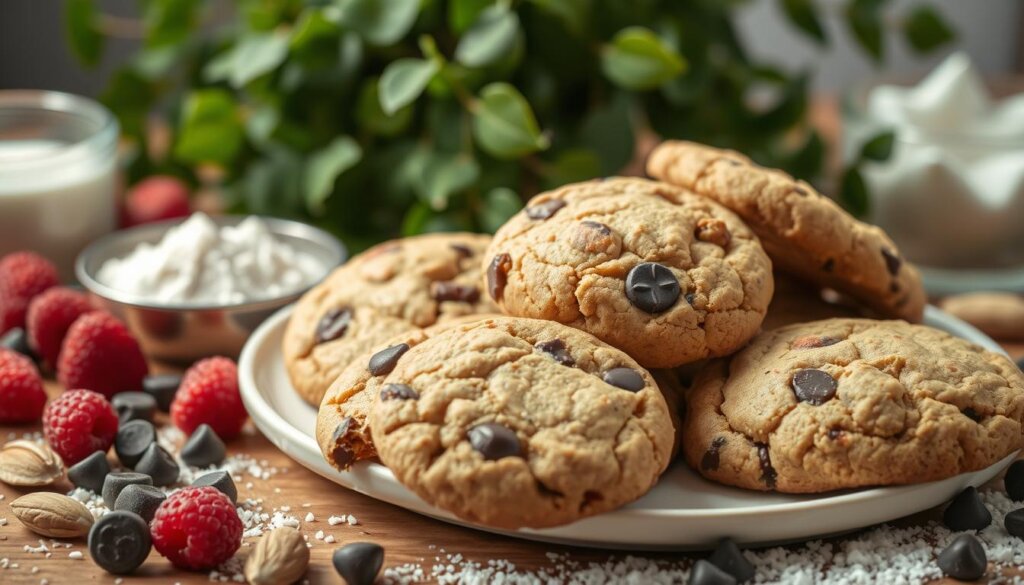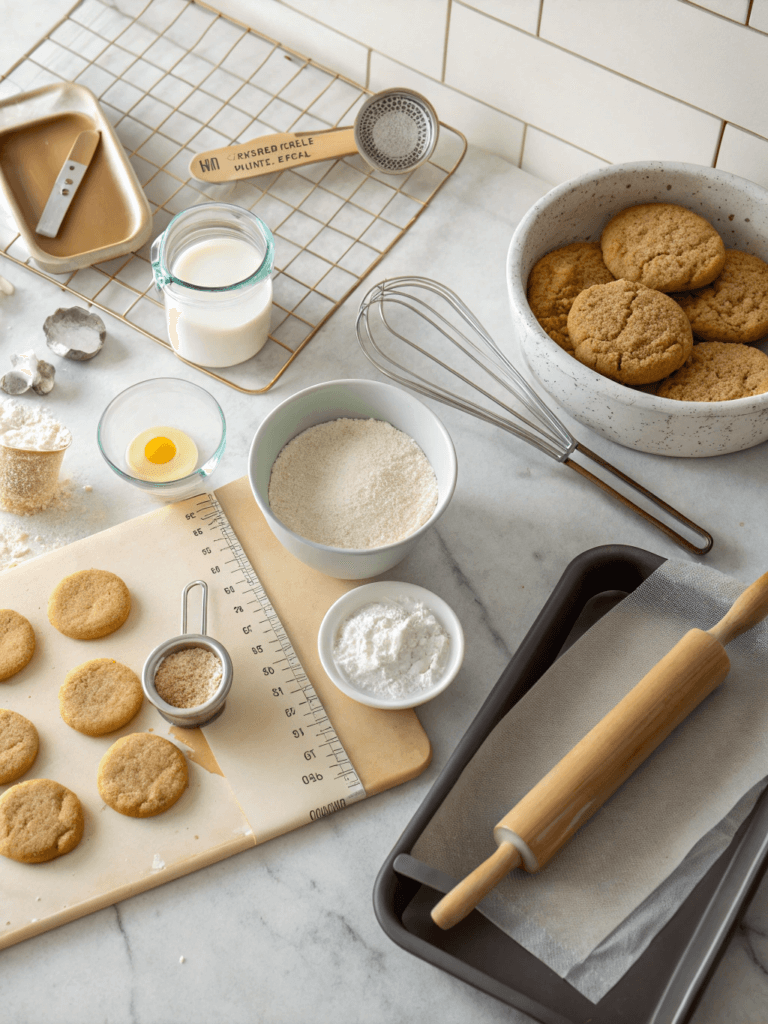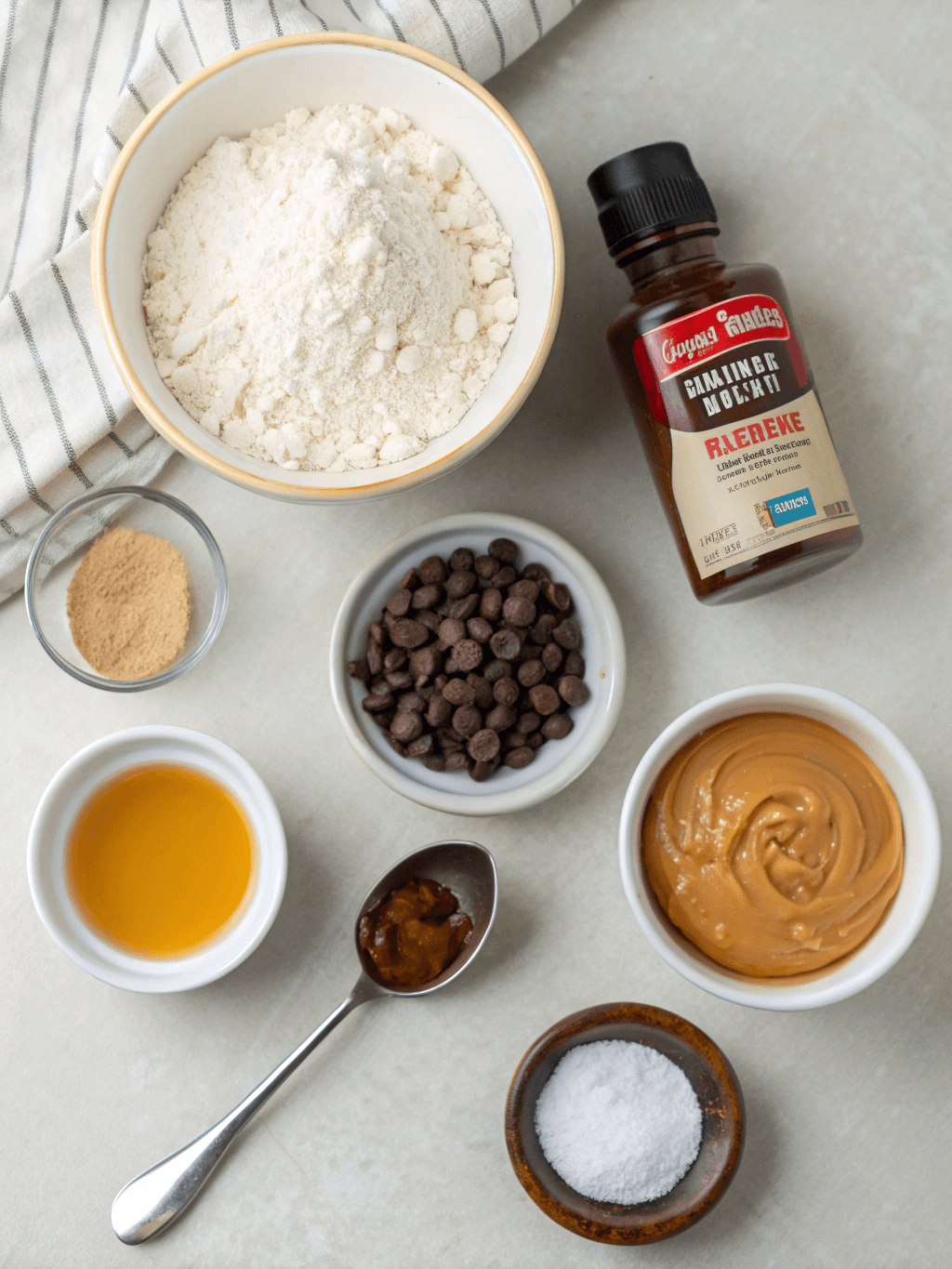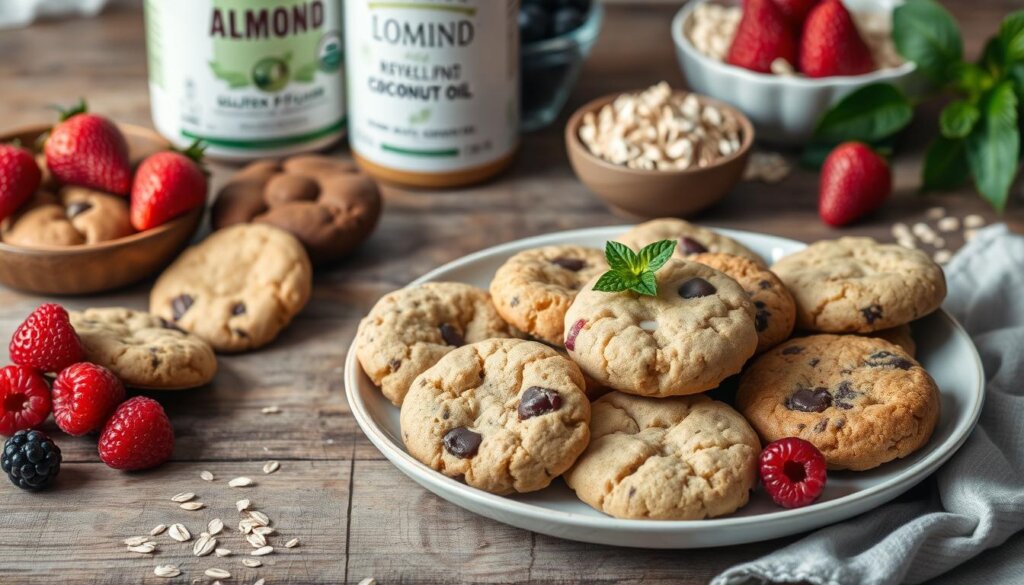Ever thought about enjoying cookies without breaking your diet rules? Gluten and dairy-free cookies are all the rage, offering delicious flavors while fitting your dietary needs.
Learn how to bake your own with our step-by-step guide, and explore other tasty options like Delicious Gluten-Free Breakfast Cookies You’ll Love, Easy Gluten-Free Cookie Dough Recipe, and The Best Homemade Gluten-Free Cinnamon Rolls Recipe.
Table of contents
- Introduction to Gluten and Dairy Free Baking
- Why Choose Gluten and Dairy Free Cookies?
- The Best Ingredients for Gluten and Dairy Free Cookies
- Essential Tools for Baking Cookies at Home
- How to Make Delicious Gluten and Dairy Free Cookies
- Storing and Freezing Your Cookies
- Fun Variations and Flavor Combinations
- Discovering More Gluten and Dairy Free Cookie Recipes
- Conclusion
- FAQ
Introduction to Gluten and Dairy Free Baking
Starting with gluten free and dairy free baking is exciting. It lets you try new things in the kitchen. You’ll learn how to bake without gluten, which is different from regular baking.
Gluten is key in regular baking. It makes dough stretchy and helps it rise. Without gluten, you need to find new ways to make things work.
Trying new things is important in gluten free baking. You might use almond or coconut flour instead of wheat. This changes how things taste and feel. You can make yummy cookies without gluten.
Using the right ingredients is also important. Look for things like allulose, which is low in calories but doesn’t raise blood sugar. Lakanto sugar-free chocolate chips are good because they’re both dairy-free and gluten-free.
Choosing the right ingredients is key in dairy free baking too. Use high-quality dairy substitutes like Violife unsalted butter. Choc Zero chocolate chips are also good because they’re free from dairy and gluten.
Learning about these ingredients and techniques will help you get better at gluten free baking. It will also make you more confident in dairy free baking. Remember, there are challenges, but they can be fun to solve.
Why Choose Gluten and Dairy Free Cookies?
Baking gluten and dairy free cookies is good for health and meets dietary needs. These options are popular today. They help people with specific diets and health goals.
Health Benefits of Gluten and Dairy Free
Many people avoid gluten because of health issues. Gluten-free cookies can help with digestion and energy. Dairy can also cause problems for some.
Choosing dairy-free cookies can improve digestion and reduce bloating. It can also help with skin issues.
Common Allergies and Dietary Preferences
Gluten and dairy free cookies are great for parties. They’re safe for those with food allergies. This makes everyone happy.
More people want healthy food choices. Gluten and dairy free cookies meet this demand. They’re a hit for health and taste.

| Dietary Focus | Key Benefits | Common Issues Addressed |
|---|---|---|
| Gluten-Free | Reduced digestive discomfort | Celiac disease, gluten sensitivity |
| Dairy-Free | Improved digestion and skin health | Lactose intolerance, dairy allergies |
| Overall Health | Enhanced energy and wellness | General health improvements |
The Best Ingredients for Gluten and Dairy Free Cookies
When baking gluten and dairy free cookies, the right ingredients are key. This section talks about the best gluten-free flours and dairy-free fats and milks. These choices will make your baking better.
Understanding Gluten-Free Flours
Choosing the right gluten-free flours is important. Almond flour and coconut flour are great options. Almond flour adds a nutty flavor and makes cookies moist and rich.
Coconut flour absorbs moisture well, making cookies sweet. Here’s a quick look at these flours:
| Flour Type | Flavor Profile | Texture Contribution | Usage Tips |
|---|---|---|---|
| Almond Flour | Nuts, mildly sweet | Moist, rich, golden color | Use in moderation; can replace wheat flour at a 1:1 ratio, but may require adjustments in liquid |
| Coconut Flour | Coconut, subtly sweet | Dense, with a cake-like texture | Use sparingly as it absorbs moisture; typically, 1/4 of the total amount of flour |
Using high-quality gluten-free flours like King Arthur Flour and Bob’s Red Mill is best. They often have xanthan gum for better texture. Blends should work well without gluten for better cookies.
Choosing Dairy-Free Fats and Milks
Finding the right dairy-free fats is key for great cookies. Coconut oil is a top choice, adding a rich flavor. Vegan butter is also good, making cookies creamy.
In summary, picking the right gluten-free flours and dairy-free fats and milks is important. With the right ingredients, you can make cookies that are just as good as traditional ones.
Essential Tools for Baking Cookies at Home
To make tasty gluten and dairy-free cookies, you need the right tools. Good baking tools make the process easier and improve your cookies. Get ready to bake by stocking up on the essentials for a great cookie-making experience.
Must-Have Baking Equipment
Some equipment is key for baking cookies well. Here’s a list of must-haves:
- Cookie Sheets: Get high-quality cookie sheets for even baking. They’re key for consistent results.
- Mixing Bowls: A set of mixing bowls helps mix ingredients easily. Choose non-slip ones for better use.
- Baking Sheets and Parchment Paper: Use parchment paper on your cookie sheets for easy baking and cleaning.
- Measuring Cups and Spoons: Accurate measurements are vital in baking. A reliable set ensures your recipes turn out right.
- Cookie Scoops: A cookie scoop makes cookies the same size, which looks nice.

Preferred Mixing Tools
Mixing tools are key in baking, even more so with gluten-free and dairy-free ingredients. Choose based on batch size:
- Hand Mixer: Great for small batches, a hand mixer mixes well without too much work.
- Stand Mixer: For big batches, a stand mixer makes mixing easier and mixes better.
- Whisk: For small tasks or mixing dry ingredients, a whisk is handy and versatile.
The right tools make baking easier and faster. Invest in these essential baking tools. They’ll help you make your gluten and dairy-free cookies even better.
How to Make Delicious Gluten and Dairy Free Cookies
This section shows how to make tasty gluten-free cookies. Follow the steps for a great baking experience. It takes about 2 hours and 40 minutes, including chilling the dough.

Step-by-Step Cookie Recipe
To make gluten-free cookies, you’ll need:
- 2 cups almond flour
- 1/2 teaspoon baking soda
- 1/4 teaspoon baking powder
- 1/2 cup coconut oil, melted
- 1/2 cup natural peanut butter
- 1/2 cup maple syrup
- 1 cup dairy-free chocolate chips (like Enjoy Life brand)
- 1 teaspoon vanilla extract
Here’s how to bake them:
- Mix almond flour, baking soda, and baking powder in a bowl.
- In another bowl, mix melted coconut oil, peanut butter, maple syrup, and vanilla extract until smooth.
- Add the wet ingredients to the dry ingredients and mix well.
- Add dairy-free chocolate chips and mix.
- Chill the dough for at least 2 hours.
- Preheat the oven to 350 degrees Fahrenheit.
- Scoop the dough onto a baking sheet.
- Bake for 10 minutes or until edges are golden.
This recipe makes 12 cookies. Each cookie has about 242 calories, 29g carbs, 4.9g protein, 9.6g fat, 2.1g fiber, and 18.1g sugar.
Tips for Perfect Texture and Flavor
For the best cookies, follow these tips:
- Chilling the dough keeps it from spreading too much.
- Don’t overbake; take them out when edges are crisp but centers are soft.
- Try different gluten-free flours for different tastes and textures.
Store cookies in an airtight container for up to 5 days. Freeze the dough for up to 2-3 months. Bake from frozen at 325 degrees Fahrenheit for the best results.
Storing and Freezing Your Cookies
Keeping your gluten and dairy-free cookies fresh is key. Use an airtight container to keep them soft and tasty. If they get too soft, refrigerate them. Here are some tips for storing cookies right.
Best Practices for Storing Cookies
- Store cookies in an airtight container to preserve their freshness.
- Refrigerate soft cookies, extending their shelf life and preventing spoilage.
- Keep different types of cookies separated to prevent flavors from mixing.
- Use parchment paper or wax paper to layer cookies in the container, which helps avoid sticking.
- Baked cookies can generally last up to one week when stored correctly at room temperature.
Freezing Techniques for Cookie Dough
Freezing cookie dough is a great way to enjoy fresh cookies anytime. Here’s how to keep your dough ready to bake:
- Portion out your cookie dough into balls or logs before freezing.
- Flash freeze the dough on a parchment-lined baking sheet for about 1-2 hours.
- Transfer the frozen dough into a freezer-safe container or sealable bag to protect against freezer burn.
- For cutout cookies, layer the dough between sheets of parchment paper to prevent sticking.
- When ready to bake, allow the frozen dough balls to sit at room temperature until softened for even baking.
Sturdy cookies like shortbread, biscotti, and chocolate chip drop cookies freeze well. But, avoid freezing delicate cookies like lacey tuiles and meringues. They might lose their quality. Properly stored cookie dough means you can bake fresh cookies with little effort whenever you want.
| Type of Cookie | Freezing Recommendation |
|---|---|
| Shortbread | Excellent for freezing |
| Biscotti | Excellent for freezing |
| Chocolate Chip | Easy to freeze |
| Lacey Tuiles | Avoid freezing |
| Madeleines | Avoid freezing |
| Oatmeal Raisin | Easy to freeze |
Fun Variations and Flavor Combinations
Trying out different flavors in gluten and dairy-free cookies makes baking fun. It lets you make cookies that everyone will love. You can add spices like cinnamon and nutmeg for a warm taste. Or, use citrus zest for a fresh flavor.
Peppermint extract is great for holiday treats. It adds a festive touch.
Incorporating Different Flavors
For unique flavors, try these ingredients:
- Cinnamon or nutmeg for spiced cookies
- Peppermint extract for a refreshing touch
- Lemon zest for a citrus kick
- Vanilla extract and paste to elevate sweetness
These can make a simple cookie recipe into something amazing. They please different tastes.
Creative Additions and Mix-Ins
Make your cookies even better with mix-ins. Here are some ideas:
- Chopped nuts for crunch
- Dried fruits for a chewier texture
- Finely chopped chocolate for rich flavor
- Colorful sprinkles for that festive flair
Each mix-in changes the cookie’s texture and taste. They’re perfect for baking for yourself or a party. They let you show off your baking skills and unique flavors.
Discovering More Gluten and Dairy Free Cookie Recipes
Exploring gluten-free cookie recipes is exciting. You’ll find many flavors and textures of dairy-free cookies. This opens up a world of baking inspiration. Try classic sugar cookies, snickerdoodles, and brownies for a taste of something new.
It’s key to balance flavors and textures when baking. Using 50% light brown sugar and 50% granulated sugar is a good start. Bicarbonate of soda helps with the right consistency, thanks to brown sugar’s acidity.

Try recipes where you can change ingredients to suit your taste. For example:
| Cookie Type | Flavor Profile | Texture Rating |
|---|---|---|
| Chocolate Chip | Sweet & Rich | 4.5 |
| Peanut Butter | Nutty & Savory | 4.0 |
| Snickerdoodle | Spicy & Sweet | 3.5 |
| Brownie Cookies | Chocolatey & Fudgy | 4.2 |
Many recipes make 24 cookies, with each cookie having 162 calories and 3 grams of protein. You can tweak these recipes to meet your needs.
As you explore gluten-free and dairy-free baking, don’t be afraid to try new things. Every cookie you bake is a chance to create something unique. Enjoy the journey and the variety of tastes you’ll discover.
Conclusion
Baking gluten and dairy free cookies at home is great. It meets special dietary needs and lets you explore new flavors. Using quality ingredients like gluten-free flour and vegan butter makes tasty treats without gluten or dairy harm.
Healthy baking shows that using almond flour and stevia boosts cookie nutrition. This makes them good for those watching their health.
The baking process is simple and fast, with cookies ready in 10 to 12 minutes. Storing them in an airtight container keeps them fresh for a week. This lets you enjoy them whenever you want.
Feel free to try different flavors and mix-ins like coconut milk or gluten-free sprinkles. Gluten and dairy free cookies offer endless kitchen fun.
Remember, baking these treats is all about being flexible. You can use flaxseed meal as a vegan egg or change the fat sources. This lets you make recipes your own way.
With many recipes out there, like Tahini Chocolate Chip Cookies and Molasses Cookies, baking can be fun and rewarding. For more ideas and recipes, check out this easy gluten-free cookie dough recipe that’s ready in just 15 minutes!
FAQ
What are gluten and dairy free cookies?
Gluten and dairy free cookies are treats without gluten or dairy. They use flours like almond or coconut and substitutes like coconut oil. They’re good for those with gluten intolerance or who follow certain diets.
Why are gluten and dairy free diets becoming popular?
More people are choosing these diets because of health reasons. Issues like gluten intolerance and lactose sensitivity are common. It’s also about feeling better and eating cleaner.
How do I achieve the right texture in gluten and dairy free cookies?
To get the right texture, try different ingredients. Use almond or coconut flour and dairy-free fats. Chilling the dough helps keep the cookies from spreading too much.
What are some common dairy-free milk alternatives?
You can use almond milk, oat milk, cashew milk, or coconut milk. These replace cow’s milk well, keeping your cookies tasty.
How should I store my gluten and dairy free cookies?
Store them in an airtight container to keep them fresh. If they’re soft, the fridge is best. This keeps them tasting good longer.
Can I freeze gluten and dairy free cookie dough?
Yes, freezing dough is great for later baking. Just freeze it, then put it in a container. It’s ready when you want to bake.
What are some creative add-ins for gluten and dairy free cookies?
Add nuts, dried fruits, or dairy-free chocolate chips to your cookies. Spices like cinnamon and nutmeg also work well. These make your cookies special and fit your diet.
Print
Gluten & Dairy-Free Cookies
- Total Time: 2 hours 20 minutes (including chilling time)
- Yield: 12 cookies
Description
Delicious and healthy gluten and dairy-free cookies with a rich texture and flavor.
Ingredients
- 2 cups almond flour
- 1/2 teaspoon baking soda
- 1/4 teaspoon baking powder
- 1/2 cup coconut oil, melted
- 1/2 cup natural peanut butter
- 1/2 cup maple syrup
- 1 cup dairy-free chocolate chips (like Enjoy Life brand)
- 1 teaspoon vanilla extract
Instructions
- Mix almond flour, baking soda, and baking powder in a bowl.
- In another bowl, mix melted coconut oil, peanut butter, maple syrup, and vanilla extract until smooth.
- Add the wet ingredients to the dry ingredients and mix well.
- Add dairy-free chocolate chips and mix.
- Chill the dough for at least 2 hours.
- Preheat the oven to 350°F (175°C).
- Scoop the dough onto a baking sheet.
- Bake for 10 minutes or until edges are golden.
Notes
– Chilling the dough keeps it from spreading too much.
– Don’t overbake; take them out when edges are crisp but centers are soft.
– Try different gluten-free flours for different tastes and textures.
– Store cookies in an airtight container for up to 5 days.
– Freeze the dough for up to 2-3 months. Bake from frozen at 325°F (163°C) for the best results.
- Prep Time: 10 minutes
- Cook Time: 10 minutes
- Category: Dessert
- Cuisine: American
Nutrition
- Calories: 242 kcal
- Fat: 9.6g
- Carbohydrates: 29g
- Protein: 4.9g





